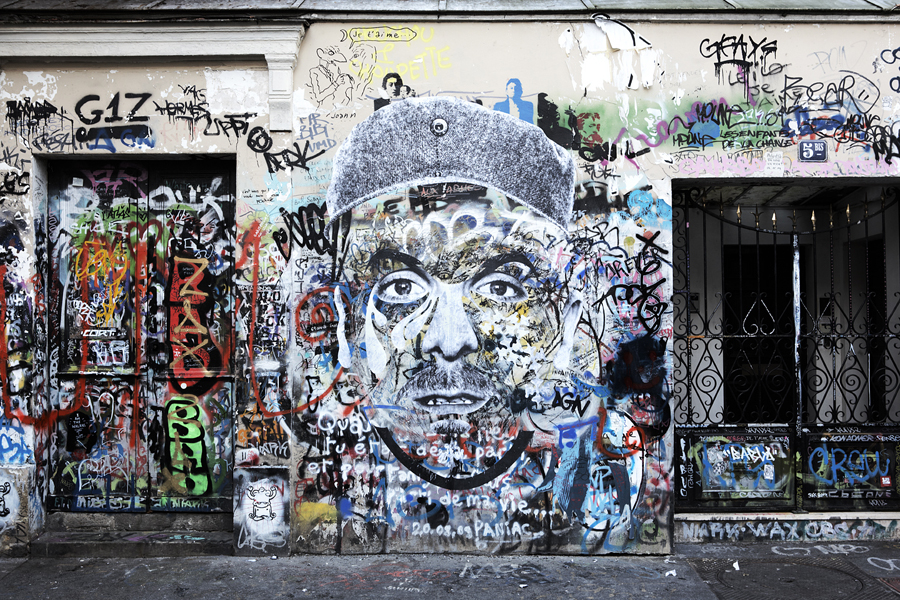
Dan Bergeron, a.k.a. Fauxreel, creates stunning photo-based street art that also explores really interesting themes - from homelessness & community to the intersection of art & advertising, so I was excited to get into it with him.
What is your history in art, how did you come to focus on photography and street art?
In terms of art, I am self-taught, although I studied Film and Sonic Design at Carleton University in Ottawa, Canada. I became seriously interested in photography once I was finished university. At first it seemed like a smart career move; I was working here and there as a freelance writer for a few magazines in Toronto and I looked at photography as a way of making myself more marketable. About 2 years passed and I was working as an assistant video editor at an advertising agency and continuing with photography as a hobby. My time inside the walls of an ad agency opened up my eyes to all sorts of design and illustration and I had access to a cold press machine that could apply adhesion to essentially any paper medium. So I put two and two together and started to turn my darkroom prints into stickers, as large as 20 x 24 inches, and began selectively putting them in spots around the city. I was thinking of the process as photograffiti, and as a way that I could express what I thought or saw to the largest amount of people possible. Now, some seven years later, I’m still working with photography and exhibiting my work outdoors, but with more thought for my surroundings, more sensitivity to the people who occupy these spaces and using regular 20 lb paper instead of photographic prints.

What attracts you to photography in street art? Who do you think is using it well?
I like how photography democratizes street art. Not only does it make the work more accessible for the viewer, because most people have taken a photo and they understand the various nuances of photographic representation, but it also allows more people the opportunity to get their work up quite easily. I’m not saying that the majority of the photos that you see pasted up are good, it’s actually the opposite, but a camera can be a very powerful tool that levels the playing field in a lot of respects.
Aesthetically, I like how black and white photos look juxtaposed against the color world. The work really pops off the wall, especially when human scale and the placement of the image is given a lot of consideration.
In terms of who’s using photography in an interesting way in street art, I definitely have to mention JR. He understands scale, placement and he thinks in big ways – all very important elements of working as an outdoor artist. However, what JR really understands and conveys through his work is how photographic representation can be used to positively enhance people’s lives and help to give the subject a voice. His work is not about him, but about the people that he photographs and pastes up around the world. He shines light on the “other”, those largely unrepresented in media, through his art.
Other photo-based artists I like who work out in the street would include Andrew01 from Vancouver, Raul Zito from Sao Paolo and Cayetano Ferrer from Chicago. Each of these artists shoot their own images and have come to create their own language in terms of utilizing their images in an original and creative way.
Other street artists who I admire, like Judith Supine or Bast, use photography in their work, but I consider this differently as they are using found photos as part of their collage and because, from my understanding, they do not photograph any of the images they use.
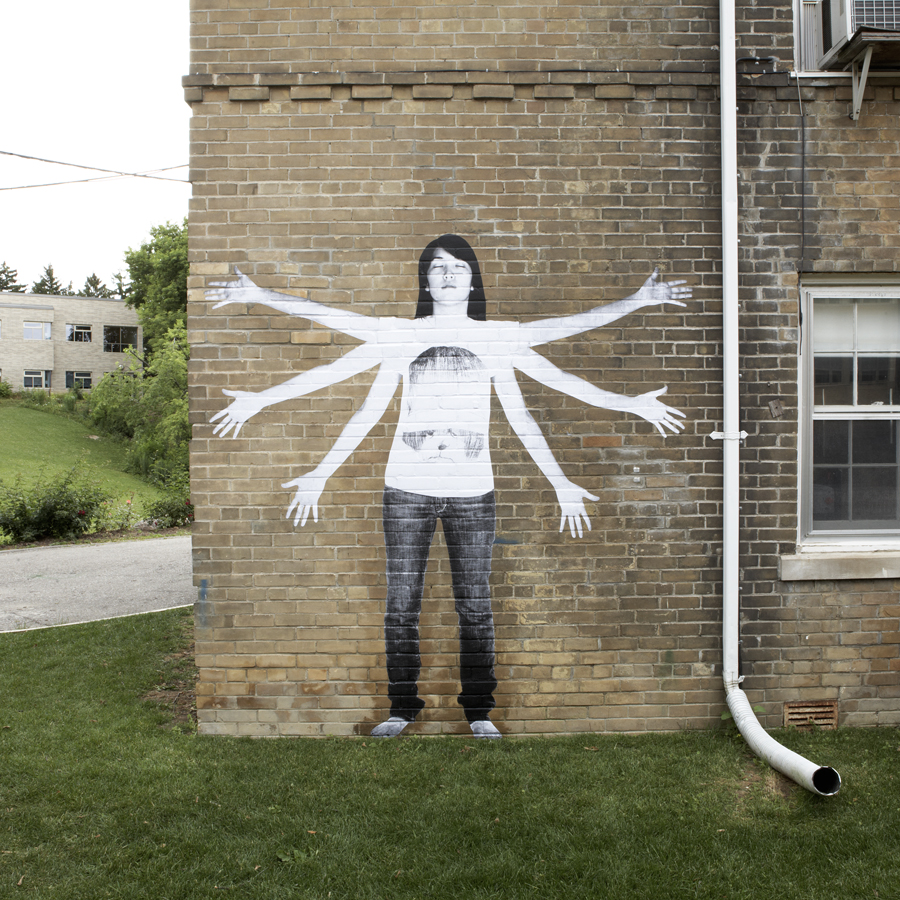
It's obviously important to you that your art tackles a subject of importance to society; when you're compelled to make a new piece, is it driven by the message you want to communicate, or by the desire to make art?
Although the outcome of a project can sometimes be bittersweet, I enthusiastically enjoy the rewards of the creative process. It’s where you challenge yourself, where the problem solving skills are honed and when you really get to be by yourself and think. So I do have a desire to create art, but that desire is strongest when the message within the work is clear, the work has a conscience and the ideas contained are tangible to the greatest amount of people possible. For me, the message and the desire to create are combined.

Do you think street art can be an effective agent of change?
I would say that street art may cause certain viewers to change ways they think about issues or their surroundings or how they interact with public space, but for the most part these changes are individualistic and although they represent change, this change may not be noticeable in society to any large degree. Having said that, the most recent example I can think of where street art effected change was Shepard Fairey’s Obama campaign. That really got a lot of people excited to vote who normally wouldn’t and it helped to change the tide of the election in Obama’s favor. The thing is though, and taking nothing away from Shepard or the campaign, but Shepard is a big time player with some money behind him and a lot of cultural influence. The average artist working illegally in the public realm doesn’t have either of those tools to help them get their point across. So in a way, street art is like anything else in terms of its power to influence. It needs the right message matched with the right background support coming from the right artist to have the greatest effect possible. If the Obama campaign was executed by Mr. Brainwash, who seems to have a positive cash flow, or by an artist like Michael De Feo, who is respected within many different artistic communities, it wouldn’t have had the same effect because all of the pieces wouldn’t have been in place.

From 'The Unaddressed' series
Of all the projects you've done, which has been most satisfying?
Tough question. I can easily tell you what project was the least satisfying. I was very dismayed by the reaction that fellow Torontonian’s had for The Unaddressed series I did focusing on issues about homelessness. The pieces got torn down, scribbled on with nasty comments and generally disrespected. Although this really got me down at first, I later realized that the work provoked a reaction and really showed what a lot of Torontonian’s think about those who are homeless.

Back to your question though, I would have to say it’s a tie between The Regent Park Portrait Project and A City Renewal Project, but for very different reasons. The Regent Park portrait series was rewarding because I got to meet a bunch of the great people that live in Regent Park, I got to help them create a more positive image for the community and I got to go as big as I wanted. In the end, the community was pleased with the outcome, the individuals were proud to have their images displayed and it was a really enjoyable and warm experience all around. On the other hand A City Renewal Project allowed me to work with my good friend Gabriel Reese, aka Specter, creating a world all our own with basically no limits. We had free space to create the installation, plenty of time to sink our teeth into the project, the opportunity to be imaginative in large-scale, a great idea to work with, the chance to stick it to the man, marvelous support from our friends, families and sponsors and no one telling us what to do. We were like those 2 kids let loose in the candy store that you sometimes hear about. Plus we managed to appropriate a bus shelter for our own devices in broad daylight.

From the 'Vespa Squareheads' series
You asked the questions as part of your 'Vespa Squareheads' series:
- 'Does (street) art lose its credibility if it has a commercial connection?'
- 'Can-an-artist-work-commercially-and-with-a-conscience-at-the-same-time?'
I'm really interested in those questions too; having done that project, did you come to any answers? Where do you think the line should be drawn? What distinguishes street art from street advertising?
I definitely think artists can work commercially and with a conscience, however, I think that if you are going to do this you should be aware of the differing motivations and you should try to make the commercial project provoking to the public in some respect. Because I like blurring the lines and playing with the public’s perceptions in some of the work I create, I immediately realized that the difficulties surrounding an illegal street campaign completed by a commercial interest would be a perfect fit for me. So I approached the Vespa Squarehead project with the goal of raising questions about the role of advertising in public space, examining the grey area between street art, graffiti and advertising and attempting to make connections between products and people’s identities. If I can complete a series of work that will pose and examine these types of questions and it will allow me to make some money at the same time, there’s nothing wrong with that in my opinion.
Will working on a project like that endear you to the public? Probably not, and for me that’s okay. I think the notion a great deal of the public holds, is that street artists should all fall under the same political leftist umbrella and they should all be anti-capitalism. This is certainly untrue (think about Banksy or Shepard Fairey as businessmen and Princess Hijab as a right wing street artist) and it would be boring if it were. Although the simple act of placing up illegal artwork can be said to have political connotations, if the work in question is a stencil of Talib Kweli or a paste up of fried chicken, the work is then purely aesthetically based and not political at all.
In terms of drawing a line between street art and street advertising and deciding what distinguishes the two, I am not the one to be judging that. I am far more interested in the overlapping areas in between and engaging with audiences who appreciate work that challenges the political status quo associated with street art, or art in general, as well as talking to fellow artists who understand these nuances and who utilize them within their work and their approach to developing their practice and essentially their brand.
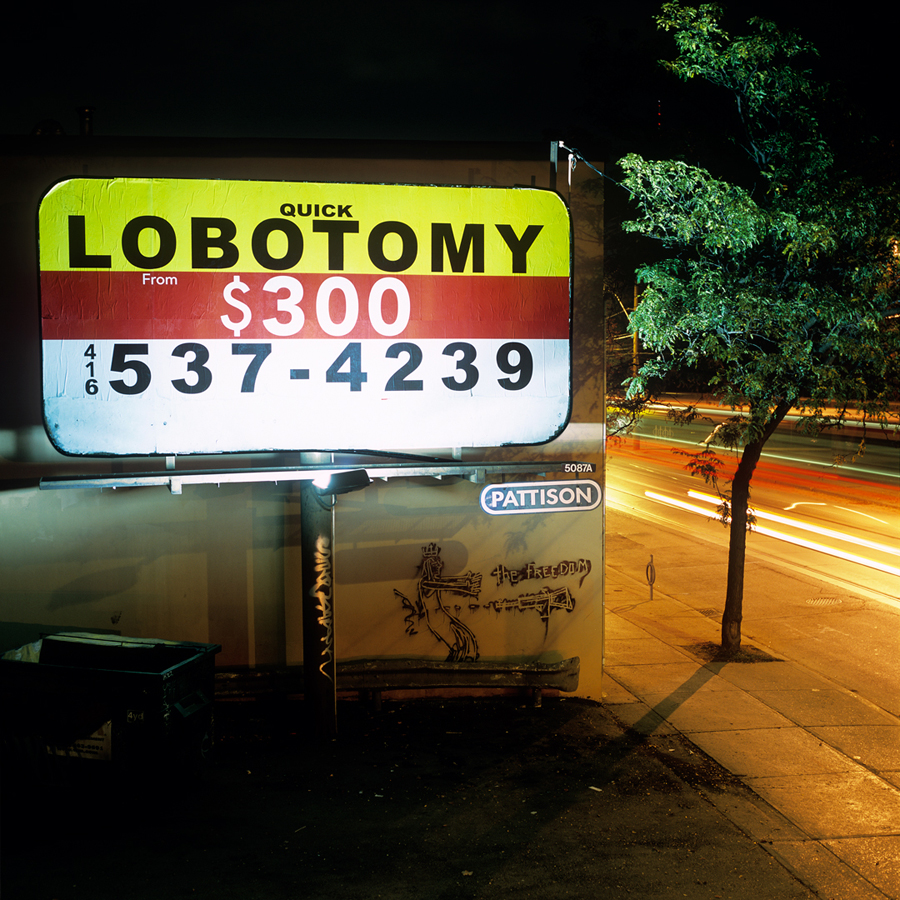
You've taught high school students about photography outside of its usual environment (e.g. in street art); what were some of the themes you taught, and how did the students react?
I’ve lead a bunch of workshops for various groups of teenagers focused on working as an artist in public space combined with using photography outside the boundaries of its traditional frame, because that is what I know best. Once I get past showing them examples of my work and the work of other artists who I think they will find interesting, I then introduce them to the idea that public space is owned by everyone, but that most of the time ownership is not granted to all. The discussion then usually shifts to advertising and ideas surrounding paying for the use of public space, what types of people are represented in popular media and advertising and issues concerning the visual representation of woman in media. In terms of photography specific themes, I like to spend time talking about how photography can be used as a tool of empowerment and how uncommissioned images put up in public space run counter to the primary outdoor visual culture of advertising. This can be tricky because I don’t want to basically tell a bunch of teenagers that it’s okay to vandalize, but I do want to encourage them to feel that they have the right to express themselves. By letting them know that there is value in creating work that speaks to people about issues that are relevant, especially in ways that are creative and site-sensitive, hopefully the kids begin to understand that there is the possibility that you can work as an artist outside the gallery system.
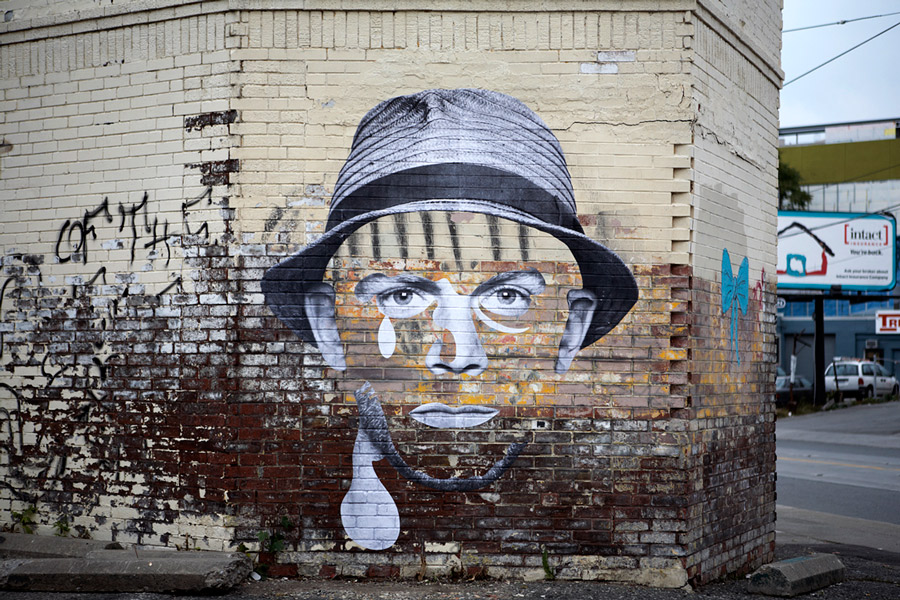
Your new 'Face of The City' project fuses the physical fabric of a city with its people (marks on walls become lines and character on faces); how do you think this series might evolve? How do you choose which faces to use?
As I mentioned in a previous question, I was disappointed with the reaction that The Unaddressed project received. Which in a way was great, because it made me step back and rethink some of my motivations, especially aesthetically, in making art for the outdoors. I spent a lot of time this last summer thinking about creating a somewhat (and I say somewhat because almost everything has been done before) original photo-based language that I could explore and experiment with for years to come. I wanted to create a body of work rather than just a series or work. What I like about what I have decided to do with the Face of the City project is that the possibilities seem endless. There are close to seven billion faces in the world and enough distressed surfaces that I never have to worry about finding a new canvas. I think what will happen is that I will start to create my own marred surfaces, or alter existing ones, which I already have, to suit my precise needs. I also want to make the pieces three-dimensional and add materials to the wall that you wouldn’t normally expect. In terms of who I am going to choose, so far everyone has been close to me. Newer pieces will focus on people visible in neighborhoods, the ones holding down corners, the ones who have been touched as my grandmother used to say.
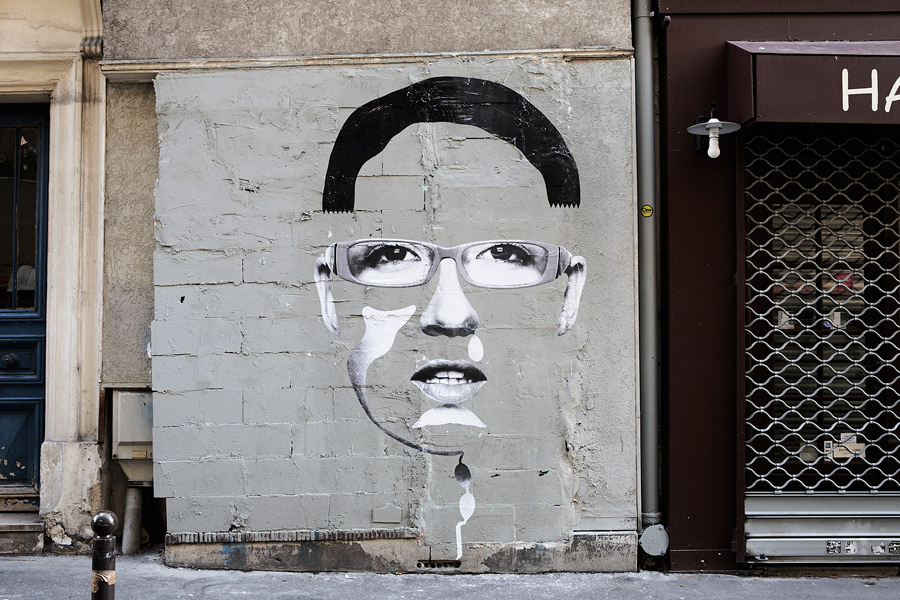
Do you subscribe to the view that 'street art' should be more than just 'art in streets', by incorporating something of the street environment into the art?
In my opinion the best street art attempts to comment on current social, political or cultural subject matter or it tries to become a part of the landscape of the city by either commenting on public space or using the space as part of the work. When public art is executed with this approach, it creates a dialogue amongst the viewers and hopefully persuades them to think about new ideas, view public spaces around them in stimulating ways and perhaps even gets them to consider the opinions of those who they would not normally listen to. To use elements of the street environment within the work adds layers of texture to the work and gives the viewer more to chew on and digest.
What are your main influences - art and otherwise?
My creative influences and those who inspire me include Richard Avedon, Gregory Crewdson, John Baldessari, David Ellis, Blu, John Coltrane, Swoon, Anish Kapoor and Ahmad Jamal to name a few. Other influences include skateboarding which taught me to look at my surroundings in inventive and out of the ordinary ways, my father who taught me to work hard and believe in myself, my friends who keep me chuckling and my girlfriend Tara who challenges me to be more thoughtful and sensitive to others, makes me feel warm and brings my life a happy balance.
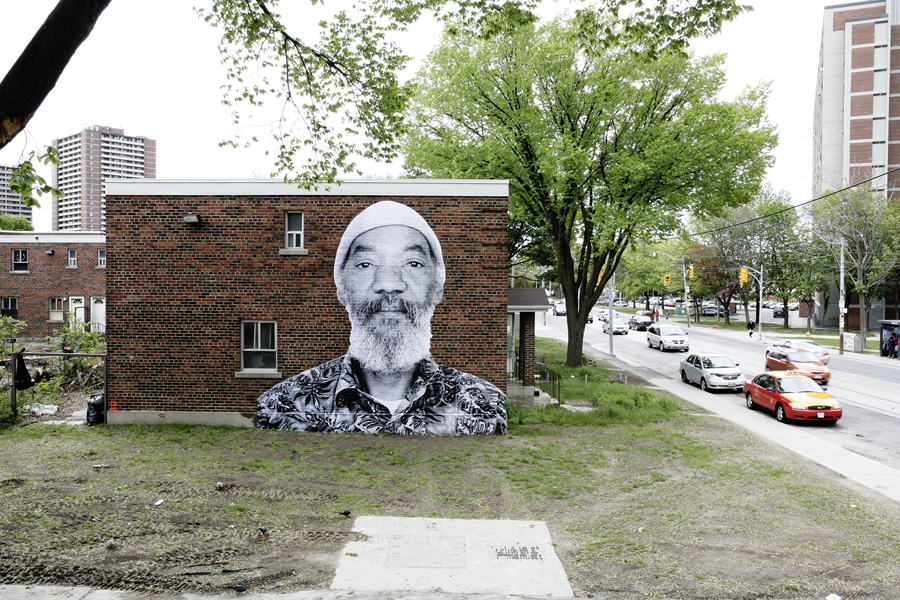
From the Regents Park Portrait project
If you could buy any three pieces of art, what would they be?
I would love to own a bronze of Jacob Epstein’s Rock Drill, one of about 5 beautiful pieces that I can think of by Swoon and a smaller version of Cloud Gate by Anish Kapoor, because if I owned the original it would be stealing it from the people of Chicago.
What's next for you?
I’m working on an outdoor installation project with the John Hansard Gallery in Southampton, England and an installation at the Museum of Canadian Contemporary Art here in Toronto, both this coming summer. I am also going to have my first solo exhibition based on the Face of the City body of work at Show & Tell Gallery in Toronto this coming September. Other than that, just working on smaller series’ of uncommissioned works for the streets and trying to expand my visual language beyond the use of photography as much as possible.
What everyone should know is...
that jerk chicken is best barbequed after a 2 day marination, the Edmonton Oilers of the 1980’s will probably be the best hockey team ever assembled and working hard often produces the best results.
Check out Fauxreel's site, and his new very limited print released through Show & Tell gallery.
tweet this post / share on facebook
© unurth
